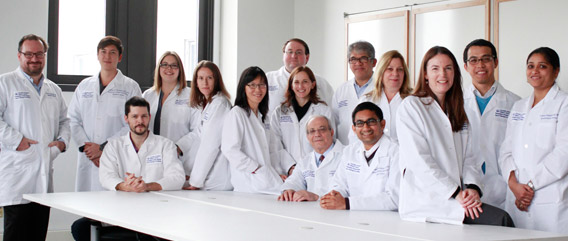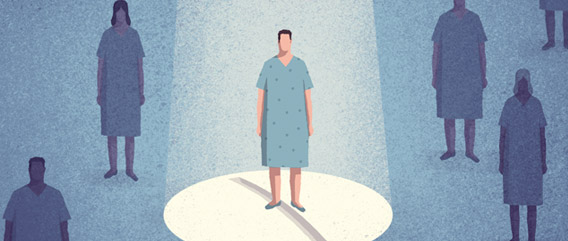Medicine Gets Personal

Columbia President Lee Bollinger announced in February the creation of a University-wide task force to explore the potential of personalized medicine “to help us plan for the extraordinary promise of new scientific advances, especially in the areas of genomics, data science, and the core science and engineering disciplines for what is variously referred to as precision, or personalized, medicine.”
P&S Dean Lee Goldman co-chairs the 41-member task force with President Bollinger and Provost John Coatsworth. Other members represent faculty from the four medical center schools, NewYork-Presbyterian Hospital, senior CUMC leadership, Morningside faculty and administrators, Columbia Trustees, and the CUMC Board of Advisers.
The broad membership of the task force reflects the broad scope of the field, from the exploration of fundamental issues of human self-understanding to the review of the legal, policy, and economic implications of revolutionary changes in scientific knowledge and medical practice.
The task force, says Dr. Goldman, will galvanize efforts around the science, policy, and clinical implementation of personalized medicine. “The adoption of this initiative by President Bollinger and the entire university is an affirmation of the vision of our faculty, who made this the top scientific priority in our strategic plan. With the commitment of all of Columbia University, we have the opportunity to broaden the intellectual approach to personalized medicine within Columbia and beyond. I can think of no better way to harness Columbia’s scientific and intellectual prowess in support of our mission to advance knowledge and health.”
Columbia is not the first university to call attention to personalized medicine, says Dr. Goldman, but “Columbia is the first major university to bring together the full breadth and depth of the entire university to advance it. The energy that comes from this initiative will galvanize work across multiple disciplines that might otherwise not be so well coordinated.”
The task force will extend the effort beyond Columbia by working in partnership with NewYork-Presbyterian Hospital, the New York Genome Center, and the New York Structural Biology Center. The task force’s full membership list is available at the end of the article at left.
A patient sits in a waiting room at Columbia’s Herbert Irving Comprehensive Cancer Center, referred to Columbia based on reported symptoms and a recent blood test. His nascent chart includes his age, birthplace, current medications, profession, medical history, and results of a recent MRI. An hour from now, that chart will also include a diagnosis and recommendations for an initial treatment plan.
The information in the chart will be used to shape and guide this patient’s care. But researchers such as Nicholas Tatonetti, PhD, assistant professor of biomedical informatics and director of clinical informatics for the cancer center, would like to know more—a lot more. Dr. Tatonetti works in a discipline known as network medicine, an integrated study of the entire network of biological processes at work in complex disease. He has his eye on the day when multiple levels of prediction, based on data from gene, protein, and metabolic interactions, in conjunction with clinical observations and understanding of disease and pharmacological processes, become the new standard of care: What do we know about this patient’s genome before he walks through the door? What are the particular molecular characteristics of his specific disease? How will it respond to treatment with the therapies available? What will be the medications’ side effects for him?
Bringing that level of precision and predictive ability to patient care—“the right drug for the right patient at the right dose at the right time”—is the goal of Columbia’s new interdisciplinary focus on personalized medicine. In the decade since the Human Genome Project completed its mission, determining the sequence of the human genome and identifying just 20,000 genes, it has become apparent that many factors—overproduction of a particular protein, infection, and environmental exposure in addition to gene mutation—affect disease mechanisms and progression. Rapidly evolving technologies that make DNA sequencing dramatically faster and less expensive along with new technologies to monitor virtually all aspects of cell physiology have led to the generation of unprecedented amounts of information (big data) that is starting to yield to new computational approaches and high speed computers, all of which promise to make diagnosis and treatment as patient-specific and precise as possible.
To harness the potential created by these scientific advances for the benefit of patients, P&S Dean Lee Goldman, MD, has made personalized medicine a key goal of the medical school’s strategic plan. “At Columbia, we have enthusiastic consensus in support of personalized medicine—the personalized application of scientific advances to modern diagnosis and treatment, easily accessible and attentive care for the people who entrust us with their health, and personalized education for each of our individual students,” says Dr. Goldman.
The effort brings together several centers under the auspices of the new Department of Systems Biology: the JP Sulzberger Columbia Genome Center, the Center for Computational Biology and Bioinformatics, and six NIH-funded centers of excellence for the study of systems biology of human disease. Other research venues involved include a full complement of shared genomics technology resources at the Herbert Irving Comprehensive Cancer Center; the newly opened New York Genome Center, of which Columbia was a founding member; the Institute for Cancer Genetics; the Department of Pathology & Cell Biology; the Department of Biomedical Informatics, and more.
Personalized medicine requires an interdisciplinary approach, which enhances collaboration across all clinical disciplines at the medical center and many basic sciences, including partnerships with researchers throughout Columbia. “The promise of harnessing genomic data to better predict the future course of disease and the efficacy of treatment for individual patients is just extraordinary,” says University President Lee C. Bollinger. “Unlocking this potential will take not only the vast research prowess of our medical center, but also the computational capacity and multidisciplinary creativity found across the University, from engineering to the basic sciences. What lies ahead is a comprehensive institutional effort commensurate with the significance of this endeavor.” (See accompanying article.)
When a tumor’s individual weakness is found—and the right tool identified to exploit that weakness—patient care can be revolutionized.
That level of collaboration is already creating enormous energy. “This is very much an evolving field,” says Wendy Chung, MD, PhD, associate professor of pediatrics in medicine and a member of the university’s newly formed task force on personalized medicine. “It’s a combined effort to learn as we go; we're trying to approach this as a partnership with providers, patients, and researchers. And by doing it in this way, we move things forward faster for patients.”
Drawing New Boundaries
At the heart of personalized medicine is a fundamental reframing of how to classify disease. In cancer, for example, medicine has long characterized diseases by cell type or location in the body, but within those categories, clinicians and researchers now know, many different types of disease exist. “One of the things that’s really come out of the investigations in the past 10 to 15 years is this finding that there is incredible heterogeneity within cancers,” says Alex J. Rai, PhD, associate professor of pathology & cell biology and director of the special chemistry laboratory at NewYork-Presbyterian Hospital. It is possible, by using the right technologies, to determine that two cancers which may look the same based upon organ or cell type classification are in fact fundamentally very different. A cancer of one organ, such as breast cancer or liver cancer, for example, should perhaps no longer be thought of as a singular disease but potentially myriad diseases. Different tumors grow and respond to therapies very differently: One cancer may grow very slowly and not pose an immediate threat to the patient’s health, while another may grow quickly and be very aggressive. One type may respond well to one medication while another type does not respond at all.
Awareness of these differences has emerged because, for the first time, researchers have the ability to get a nearly complete molecular picture of an individual patient’s tumor, says Brent Stockwell, PhD, associate professor of biological sciences, chemistry, and systems biology and a Howard Hughes Medical Institute Early Career Scientist. “The question is, given all that information, what is the Achilles’ heel of that particular tumor?”
That is the question driving much of cancer research. And when a tumor’s individual weakness is found, and the right tool identified to exploit that weakness, patient care can be revolutionized. One early example was the success of the targeted therapy imatinib, which won FDA approval in 2001 to treat chronic myeloid leukemia. “Since then, the goal has been to extend this approach to all other tumors,” says Stephen Emerson, MD, PhD, director of Columbia’s Herbert Irving Comprehensive Cancer Center. But other types of leukemia, even though they have similar-looking cancer cells, are caused by very different mutations and so remain untreatable. “Our job is to figure out the best technologies to use to distinguish one type of cancer from another based upon its genetics, then to figure out what the right clinical studies are to test what we think are the best ways to treat them based upon those genotypes.”
Personalized medicine, then, seeks to dismantle the notion of one-size-fits-all therapies. “It’s really looking at the molecular etiology of disease or susceptibility to disease,” says Dr. Chung. What epigenetic drivers or genetic defects are propelling each individual tumor to grow or metastasize? Discovering individual disease mechanisms not only reveals the great heterogeneity within traditional categories of cancer, but also blurs the boundaries between those traditional categories, sometimes revealing similar causes of seemingly disparate types of cancer. This too holds important promise for therapy. “If we see the same molecular drivers in cancers in other parts of the body, we can co-opt existing medications for those other tumors.”
Use of Personalized Medicine Beyond Cancer
While personalized medicine has thus far had the greatest impact on cancer diagnosis and treatment, its promise at Columbia encompasses everything from neurodegenerative disease to stillbirth to depression. As Dr. Chung looks for novel breast cancer susceptibility genes in Ashkenazi Jewish families, she also does parallel work in pediatric cardiomyopathy, searching for potential molecular causes in the 30 percent to 50 percent of cases in which a genetic basis for the disorder has not yet been determined.
Dr. Chung also works on determining the molecular characterization of uncommon disorders such as pediatric neurodevelopmental disorders. “I think we’ve had extraordinary success with children with rare disorders where we haven’t a clue what’s caused it—being able to find out, using our most powerful genomic technologies, and now making diagnoses, and in some cases diagnoses that immediately suggest a therapy,” she says. In one instance, she and her colleagues identified a cause of one child’s rare condition, which they were able to cure with a liver transplant. In another case, they determined the exact cause of a disorder in two children, who are now preparing for bone marrow transplants that offer a known cure.
Researchers in the Department of Obstetrics & Gynecology’s Division of Maternal-Fetal Medicine are using genetic and environmental markers to predict which pregnancies are at high risk for complications—thereby limiting additional testing to appropriate patients and reducing unnecessary procedures for women at low risk. Such approaches offer the potential for improving prenatal diagnosis as well. Ronald Wapner, MD, vice chair of research and director of reproductive genetics, in collaboration with Bryn Levy, PhD, professor of pathology & cell biology and director of the Cytogenetics Laboratory, studies the use of chromosomal microarray analysis, a technique that finds anomalies in about 6 percent of fetuses who appear normal in current testing methods, and collaborates with Dr. Chung to sequence the genomes of fetuses with structural anomalies. “We needed better genetic tools to diagnose those problems. Genomics, in particular, has been really important,” Dr. Wapner says. “We can give parents better prognostic information about the best care for that fetus and child when it’s born.”
Ali Gharavi, MD, associate professor of medicine and chief of the division of nephrology, uses genomic technology to study several forms of kidney disease, including a constellation of congenital renal defects known as CAKUT, which now shows linkages to other disorders. When he and his colleagues looked at 500 children with kidney malformations from 10 different centers across the world, they realized that 10 percent of the children had a major chromosomal disorder not picked up on clinical evaluation. The disorders had been described but in the context of intellectual disability, autism, or schizophrenia—not kidney malformations. “It turns out that in a subset of these children with kidney failure, there may actually be a genetic lesion affecting both kidney and neurologic development that is not being addressed,” Dr. Gharavi says. In CAKUT patients who do not have a chromosomal abnormality, he can use genome sequencing to diagnose other unrecognized genetic diseases, or even define new ones. “Making a precise diagnosis is very helpful because you can identify the syndrome; you can evaluate the patient’s risk for other health problems; and you can much better inform the family about what may be going on, and what’s the risk to the next pregnancy. By finding shared biological pathways with other disorders, we may find that some drugs used for treating other conditions may be useful for the treatment of kidney disease.”
The research of two other members of the university’s personalized medicine task force focuses on research in genetics and beyond. Gerard Karsenty, MD, PhD, the Paul A. Marks Professor of Genetics & Development, department chair, and professor of medicine, studies the role of the skeleton as an endocrine organ capable of influencing other organs via secretion of the hormone osteocalcin. Dr. Karsenty investigates the molecular mode of action in osteocalcin’s remarkable effects on other organs, regulating systems including glucose metabolism, energy expenditure, male fertility, and cognition. Angela M. Christiano, PhD, the Richard and Mildred Rhodebeck Professor of Dermatology and professor of genetics & development, has unraveled the genetic basis of complex autoimmune diseases, in particular a form of hair loss known as alopecia areata. A team that includes Dr. Christiano, immunologist Raphael Clynes, MD, PhD, and dermatologist Julian Mackay-Wiggan, MD, has built a translational pipeline focusing on hair disorders, spanning from genetic studies to preclinical mouse models to clinical trials using drugs that were selected on the basis of understanding the genetics and pathophysiology of the disease. These studies promise to enable personalized therapies for hair loss disorders using patient-derived stem cells for the common forms of hair loss and use of drugs that are already showing success in treating alopecia areata.
 Members of the Department of Pathology’s personalized genomic medicine lab
Members of the Department of Pathology’s personalized genomic medicine labThe Department of Pathology’s Laboratory of Personalized Genomic Medicine is a Clinical Laboratory Improvement Amendments (CLIA)-approved laboratory. Its 10 board-certified geneticists and pathologists use a variety of biochemical and genomic platforms to evaluate a wide range of genetic and neoplastic disorders. Peter L. Nagy, MD, PhD, assistant professor of pathology & cell biology, is one of the laboratory’s directors who lead the effort to develop and validate the exome and transcriptome sequencing tests that are offered for clinical use. He sums up the mission of the laboratory: “We want to provide a genetic diagnosis that guides the clinicians to treat their patients and helps patients to cope with their disease. The laboratory works as a team with clinical colleagues from across the medical center to accomplish this goal.”
Personalized Medicine Means Interdisciplinary Medicine
And what if no actionable genetic or epigenetic mutations can be found? At the center of Columbia’s personalized medicine effort is the new Department of Systems Biology, which brings together researchers specializing in molecular biology, genetics, computational biology and bioinformatics, structural biology, mathematics, chemistry and chemical biology, physics, computer science, and other fields. According to founding director and chair Andrea Califano, PhD, the Clyde and Helen Wu Professor of Chemical Systems Biology, the new department seeks to provide an in-depth, systemwide characterization of all molecular interactions. It is this systems-level approach to disease biology that can systematically identify disease drivers and druggable targets for the 90 percent of cancer patients who lack a clearly actionable genetic mutation. This has become possible only in recent years through major advances in science and technology that require a fully interdisciplinary approach.
Dr. Califano, who serves on the NCI precision cancer medicine working group, collaborates with clinicians across the medical center—including those studying prostate cancer, breast cancer, neuroendocrine tumors, and glioma—to develop personalized therapy, including combination therapy, the use of multiple drugs to kill tumors lacking the actionable mutations that would make them sensitive to single targeted agents. He identifies instances in which simultaneous inhibition of two unmuted genes completely shuts down a tumor, but inhibiting each gene individually has no effect on cancer growth. “If you shut down one or the other, nothing happens. If you shut down both of them, these tumors cannot cope and their cells die,” Dr. Califano says. In collaboration with Jose Silva, PhD, assistant professor of pathology & cell biology, and with clinicians Matthew Maurer, MD, and Kevin Kalinsky, MD, assistant professors of medicine, Dr. Califano has launched a phase one/two clinical trial for combination therapy in HER2-positive breast cancer patients who are resistant to treatment with trastuzumab.
The work of systems biology underscores how the promise of personalized medicine depends upon the creation of powerful new teams of researchers and clinicians from across the medical center and the university. “It’s engendering a novel method of treating disease in a multidisciplinary way,” Dr. Califano says.
Technology as Power
In all of these efforts, technology is the power source. Jingyue Ju, PhD, the Samuel Ruben-Peter G. Viele Professor of Engineering, professor of chemical engineering and of pharmacology, and director of the Center for Genome Technology and Biomolecular Engineering at Columbia, is one of the world’s leading innovators of technology that makes sequencing faster, cheaper, smaller, and more accurate.
Dr. Ju, who co-invented the fluorescence energy transfer sequencing technology that enabled the completion of the Human Genome Project, is now working with next-generation sequencing—known as massively parallel four-color DNA sequencing by synthesis (SBS). This SBS platform, which uses cleavable fluorescent nucleotide reversible terminators invented in Dr. Ju’s laboratory, is the dominant approach for next-generation DNA sequencing systems. He also co-leads a team that recently received a $5.25 million NIH grant to develop a miniaturized handheld device for single-molecule electronic DNA sequencing. “The goal in mind is that the ultimate system you develop needs to be user-friendly, robust, and economical,” he says. “Electronics coupled with innovative molecular engineering can really be miniaturized, so this can be the next wave, in particular for health care and personalized medicine.”
Genomics technologies, too, underscore how research facilities are connected. In its Department of Systems Biology, Columbia has grouped all the computational activities and high-throughput data generation activities (sequencing and drug screening) under one umbrella. “We run the Columbia Genome Center, where we can screen millions of compounds in a week,” says Dr. Califano. “So we’re now running a large number of drug assays, including collaborations with the Stem Cell Initiative and with the cancer center.” The new department has become a core facility of the cancer center, which is heavily engaged in the application of genomic technology to the study and treatment of cancer. Adds Dr. Emerson, “We have also developed, through the support of the National Cancer Institute and donors, 15 shared core facilities in areas like proteomics or genomics technologies that provide the analytics you need to figure out what these tools mean.”
Columbia’s leadership in the New York Genome Center consortium extends the medical center’s genomics capabilities. The NYGC’s new facility provides comprehensive services, including sequencing, bioinformatics analysis, experimental design, high-performance computing, and data storage. An important figure in the creation of the NYGC has been co-founder Tom Maniatis, PhD, the Isidore S. Edelman Professor and chair of the P&S Department of Biochemistry & Molecular Biophysics. One of the early leaders in molecular biology, Dr. Maniatis led the development of recombinant DNA methods and their use in the study of gene regulation mechanisms. He describes the dual purpose of NYGC to complement and link its participating institutions. “The role of the NYGC is both structural and intellectual. The structure is the large-scale sequencing capacity, bioinformatics, and data storage. And the center will also act as an intellectual ‘hub’ for scientific exchanges, meetings, education, and collaborations.”
The importance of the collaborative NYGC has become increasingly clear in recent months. In January the center became one of the five genome centers in the world to acquire the Illumina HiSeq X Ten system, which is expected to enable ultra-high throughput sequencing of whole human genomes. Systems in the previous generation took many weeks to process, but the new technology is designed to provide a prompt readout of the entire genome within three days for a reduced cost of approximately $1,000 per genome. More recently, the center announced an initiative with IBM to test the IBM Watson cognitive system for genomic research that may help oncologists deliver more personalized care to cancer patients. The first project will be to evaluate Watson’s ability to help oncologists develop more personalized care for patients with often-fatal brain tumors called glioblastomas.
Two of the newest researchers at the NYGC have joint appointments at Columbia. Tuuli Lappalainen, PhD, and Joe Pickrell, PhD, have joined the center as junior investigators and core members. Dr. Lappalainen, a statistical geneticist, holds a joint appointment in systems biology at CUMC, and Dr. Pickrell, a human geneticist, holds a joint appointment in biological sciences at Morningside, strengthening the cross-campus links to Columbia’s institutional membership in the NYGC.
The Future is Now
For Dr. Chung, another key to advancing personalized medicine at Columbia is using informatics to leverage the possibilities inherent in the electronic medical record. “This is about being able to take very complex data and analyze it, but it’s also about supporting physicians or other providers, in real time, to make the right decisions for the patient,” she says. That can be accomplished by pre-populating electronic medical records with both patient-specific and disease-specific genetic and genomic information. “Through an electronic medical record—the EMR—you can help clinicians understand this information and integrate it. You don’t distract them with useless information. And they don’t forget it over time; it comes to them, they’re reminded of it, it taps them on the shoulder.”
In the Department of Biomedical Informatics, Dr. Tatonetti is adapting algorithms he developed for the FDA’s Adverse Event Reporting System to the EMR. “The goal will be to do a variety of predictive analytics where we dynamically identify patient groups and cohorts,” says Dr. Tatonetti. “Then we customize predictive models to anticipate what adverse drug effects they might encounter, or who might be required to return to the hospital, or who might have the best outcomes for a particular drug.”
Advances in personalized medicine have, of course, raised complicated ethical and administrative considerations in terms of patient care and communication. “When you start generating an entire genome’s worth of sequence on a person, the question becomes, what does the patient want to know from that?” says Dr. Chung. Some patients may want to know everything, some may want to know nothing, and others may opt to get information in stages, as public awareness evolves and as personal interest in what they want to know changes as they age. “There are some real ethical puzzles that we’re dealing with right now in trying to think through, as well as provide, mechanisms to do this in line with patient preferences—to make sure we understand what they want and to give them the correct information,” says Dr. Chung.
Resolving these types of issues will become more pressing if sequencing technologies and personalized medicine continue to advance at the current pace—as most researchers expect that they will. Dr. Tatonetti is optimistic about what these advances mean for the medical center. “Down the road, we can really leverage this new technology that we’ve been installing in the hospital and the clinic to make this vision of a learning health center a reality, where we are constantly changing and adapting our clinical practice to suit the needs of the patient population at that second,” he says. That fluidity, he adds, would also include trials. For example, if he had a hypothesis about a new drug-drug interaction that might be dangerous, he could automatically launch a trial that would reside in the clinical record, monitoring patients as they are prescribed these drugs, even suggesting to physicians who want to participate that they can adapt their behaviors. “We can monitor those behaviors over time. Instead of taking five or 10 years for us to identify a new drug interaction, it could take months, or less than a year.”
Dr. Chung believes that Columbia’s emphasis on personalized medicine has an implicit advantage in the medical center’s diverse patient population. “That really gives us tremendous opportunities in terms of the practical impact of this,” she says. “We have the ability to make this very widely accessible, based on differences in race and ethnicity, in socioeconomic levels, in educational levels, in cultural backgrounds. Because if we can make it work here, you can make it work anywhere.”
Personalized Medicine Task Force Members
Lee C. Bollinger, President and Seth Low Professor of the University, Task Force Chair
Lee Goldman, Executive Vice President for Health and Biomedical Sciences and Dean of the Faculties of Health Sciences and Medicine; Harold and Margaret Hatch Professor of the University and Professor of Medicine and of Epidemiology, Task Force Co-chair
John Coatsworth, Provost; Professor of International and Public Affairs and of History, Task Force Co-chair
Steve Corwin, Professor of Clinical Medicine and Chief Executive Officer, NewYork-Presbyterian Hospital
Amelia Alverson, Senior Vice President, Columbia University Medical Center Development
Paul Appelbaum, Elizabeth K. Dollard Professor of Psychiatry, Medicine and Law
Richard Axel, University Professor of Biochemistry, Molecular Biophysics and Pathology
Suzanne Bakken, Alumni Professor of the School of Nursing and Professor of Biomedical Informatics; Director, Center for Evidence-based Practice in the Underserved
Peter Bearman, Jonathan R. Cole Professor of Sociology; Director, Interdisciplinary Center for Innovative Theories and Empirics
DuBois Bowman, Professor of Biostatistics; Chair, Department of Biostatistics
Mary Boyce, Dean of The Fu Foundation School of Engineering and Applied Science and Morris A. and Alma Schapiro Professor; Professor of Mechanical Engineering
Andrea Califano, Clyde and Helen Wu Professor of Chemical Biology (in Biomedical Informatics) and Professor of Biochemistry and Molecular Biophysics (in the Institute for Cancer Genetics); Chair, Department of Systems Biology
Angela Christiano, Richard and Mildred Rhodebeck Professor of Dermatology and Professor of Genetics and Development; Director, Basic Science Research Group of Dermatology
Wendy Chung, Associate Professor of Pediatrics (in Medicine)
Steve Coll, Dean of the Graduate School of Journalism and Henry R. Luce Professor of Journalism
Mary D’Alton, Willard C. Rappleye Professor of Obstetrics and Gynecology; Chair, Department of Obstetrics and Gynecology; Director of Services, Sloan Hospital for Women
Robert Darnell, Robert and Harriet Heilbrunn Professor of Cancer Biology, The Rockefeller University in the City of New York; Director for Science Programs, Center for Clinical and Translational Research, The Rockefeller University in New York City; Investigator, Howard Hughes Medical Institute; Senior Physician, The Rockefeller University Hospital; Adjunct Attending Neuro-Oncologist, Memorial Sloan-Kettering Cancer Center
Harold Edgar, Julius Silver Professor of Law, Science and Technology
Stephen Emerson, Clyde and Helen Wu Professor of Immunology (in Medicine) and Professor of Microbiology and Immunology (in the Herbert Irving Comprehensive Cancer Center); Director, Herbert Irving Comprehensive Cancer Center
Ken Forde, University Trustee; Jose M. Ferrer Professor Emeritus of Surgery
Linda Fried, Dean of the Mailman School of Public Health and DeLamar Professor of Public Health Practice; Senior Vice President, Columbia University Medical Center; Professor of Epidemiology and of Medicine
Linda Green, Armand G. Erpf Professor of Business
George Hripcsak, Vivian Beaumont Allen Professor of Biomedical Informatics; Chair, Department of Biomedical Informatics
Tony Jebara, Associate Professor of Computer Science
Gerard Karsenty, Paul A. Marks Professor of Genetics and Development and Professor of Medicine; Chair, Department of Genetics and Development
Robert Kasdin, Senior Executive Vice President
Don Landry, Samuel Bard Professor of Medicine; Chair, Department of Medicine
David Madigan, Executive Vice President for Arts and Sciences and Dean of the Faculty of Arts and Sciences; Professor of Statistics
Tom Maniatis, Isidore S. Edelman Professor of Biochemistry; Chair, Department of Biochemistry and Molecular Biophysics
Richard Mayeux, Gertrude H. Sergievsky Professor of Neurology, Psychiatry and Epidemiology (in the Gertrude H. Sergievsky Center and Taub Institute for Research of Alzheimer’s Disease and the Aging Brain); Chair, Department of Neurology; Director, Gertrude H. Sergievsky Center; Co-Director, Taub Institute for Research of Alzheimer’s Disease and the Aging Brain
Kathleen McKeown, Henry and Gertrude Rothschild Professor of Computer Science; Director, Institute for Data Science and Engineering
Amber Miller, Professor of Physics; Dean of Science, Faculty of Arts and Sciences
Siddharta Mukherjee, Assistant Professor of Medicine
G. Michael Purdy, Executive Vice President for Research; Professor of Earth and Environmental Sciences
Jack Rowe, Professor of Health Policy and Management
Ursula Staudinger, Robert N. Butler Professor; Director, Robert N. Butler Columbia Aging Center
Christian Stohler, Dean of the College of Dental Medicine; Senior Vice President for Dental Medicine, Columbia University Medical Center; Professor of Dental Medicine
Fred Van Sickle, Executive Vice President for University Development and Alumni Relations
P. Roy Vagelos, Chair, Board of Advisors, Columbia University Medical Center; Chairman of the Board, Regeneron Pharmaceuticals; Retired Chairman of the Board and Chief Executive Officer, Merck & Co. Inc.
Gordana Vunjak-Novakovic, Mikati Foundation Professor of Biomedical Engineering and Professor of Medical Sciences (in Medicine)
Charles Zuker, Professor of Biochemistry and Molecular Biophysics and Neuroscience
Andrea Crawford contributed writing to this article.
- Log in to post comments




